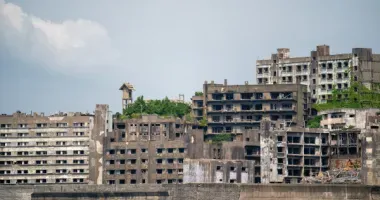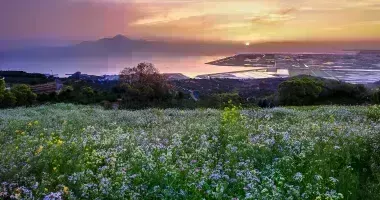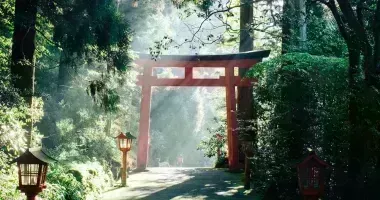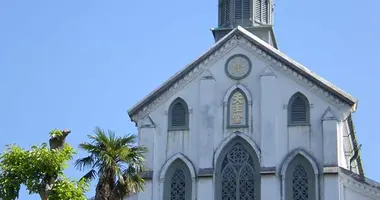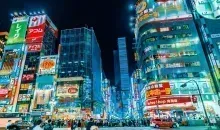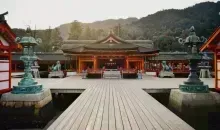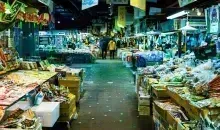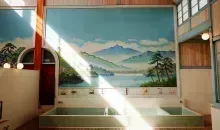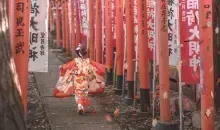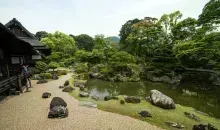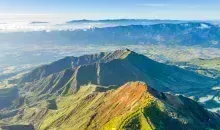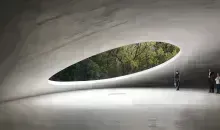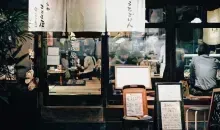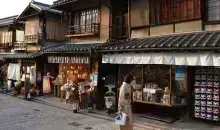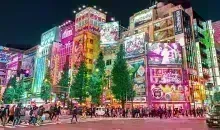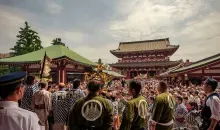Shimabara & Mount Unzen Guide
Shimabara & Unzen: read a guide to Shimabara & Mount Unzen on the Shimabara Peninsula in Nagasaki Prefecture, Kyushu.
Shimabara Peninsula & Unzen 島原半島, 雲仙
 Shimabara Castle, Shimabara, Kyushu
Shimabara Castle, Shimabara, Kyushu
The Shimabara Peninsula is located west of Nagasaki city in Nagasaki Prefecture. The active volcanoes of Unzen (雲仙) dominate the center of the peninsula and the massive peaks of the volcano: Fugendake (1,359 meters) and Heisei Shinzan (1,486 meters) are clearly visible from most of the peninsula.
The volcano erupted with deadly effect in 1792 killing over 15,000 people in a tsunami and again in 1991, when 43 people died. The Unzen Disaster Hall includes the scorched TV cameras of the doomed camera crews when the volcano erupted, photographs, panels and interactive displays. The Great Eruption Theater aims to give visitors something of the atmosphere of being in the middle of a volcanic eruption.

Daikyoukan Jigoku, Mount Unzen, Nagasaki Prefecture
Unzen Onsen Resort, Nagasaki Prefecture
Unzen
The small town of Unzen is a noted onsen resort with very hot water! There are many luxury hotels with hot springs as well as three public baths to soak in at a lower cost. Like Beppu in Oita Prefecture, Unzen is known for its scalding jigoku (hells) hot springs and boasts one of Japan's first golf courses laid out in 1913.
Unzen can lay claim to Japan's first national park - the Unzen-Amakusa National Park - established as early as 1934 along with Kirishima and the Seto Inland Sea.
Buses run from the Shimatetsu bus station in Unzen town to the start of the trails to see the volcanoes. A ropeway takes visitors from the Nita Pass to an observation platform west of Fugen-dake. Buses to the ropeway leave from Unzen's Ken-ei bus station.
The Unzen Tourist Information has a map of a suggested walk to see the various jigoku including Daikyoukan jigoku, Hachiman jigoku and Oito jigoku. There is a strong smell of sulphur in the air as you observe the steam rising from the hells.
During the time of the persecution of Christians in the early Edo Period, believers who refused to recant would be brought to Unzen to be executed in the jigoku. They would often have their ears cut off and be marched to Unzen from other areas of Kyushu. Altogether 33 people were executed in Unzen between 1627 and 1633.
There is a large cross on a hill in Unzen that serves as a monument to these Christian martyrs. Another monument Seika Moyu by artist Tokutomi Soho also commemorates the tragic events.
Legend has it that the area was first developed by the priest Gyoki in the Nara Period around 701. The mountain was considered spiritual and it was referred to as the "Koyasan of the West". No women, at that time, were allowed on the mountain.
 Warning sign at Unzen Onsen Resort
Warning sign at Unzen Onsen Resort Shimabara Castle
Shimabara Castle
Shimabara
The port city of Shimabara on the east coast of the peninsula is a sleepy place but has a few noteworthy attractions. Shimabara Castle, which dates from 1625, being the principal attraction in town.
Matsukura Shigemasa, who had replaced the Christian daimyo Arima Naozumi, raised taxes to pay for the building of Shimabara Castle and this financial burden, added to his ruthless suppression of his Christian subjects, was a major reason behind the unsuccessful Shimabara Rebellion of 1637-38.
The castle was besieged during the hostilities but not significantly damaged. Shimabara Castle was later to be under the control of the Koriki, Matsudaira and Toda clans through the Edo Period (1600-1868).
There are a number of museums in the castle and its grounds including the Shimabara Cultural Hall with more on the Shimabara Rebellion and Nagasaki Prefecture's Christians, the Fugen-dake Museum with exhibits of the local volcano's destructive eruption in 1792. The Sculpture Museum is dedicated to the work of Seibo Kitamura (1884-1987), whose art included the Peace Statue in Nagasaki. The free Folk Museum has exhibits from the Edo, Meiji and Showa periods of Japanese history.
 Mount Unzen, Shimabara, Nagasaki Prefecture, Kyushu, Japan
Mount Unzen, Shimabara, Nagasaki Prefecture, Kyushu, Japan
 Buke-yashiki, Shimabara
Buke-yashiki, Shimabara
Buke-yashiki
A short walk from the entrance to the castle is the Buke-yashiki area of lower and middle samurai houses, with a small spring water canal running down the middle of the street, that served for daily water needs. A number of the wooden residences and gardens have been preserved including the Torita, Shinozuka and Yamamoto homes.
Other reminders of Shimabara as a samurai castle town are the Old Shimabara Province Herb Garden laid out in 1834 and the City of Swimming Carp - a stone-lined canal stocked with around 1,500 of the colorful fish.
Shimabara's other attractions include a number of onsen public baths, footbaths (ashiyu) and the Hamanokawa Spring which is still used for washing food and dishes.
The 8.6m-long Statue of Buddha Entering Nirvana in Kotoji Temple (Tel: 0957 62 2788) was built in 1957 to honor Itakura Shigemasa, who commanded the Tokugawa government forces against the rebels during the Shimabara Rebellion. The statue is the longest reclining Buddha in the country.
The Unzen Disaster Memorial Hall, south of the Ferry Terminal is dedicated to the fatal eruptions of Mount Unzen in the 1990's.
The Tourist Information Center (Tel: 0957 62 3986) is in the ferry terminal to the south of the old town.
 High speed ferry, Shimabara Port
High speed ferry, Shimabara Port Slow ferry, Shimabara Port, Nagasaki
Slow ferry, Shimabara Port, Nagasaki
Access - how to get to Shimabara
Air
Nagasaki Airport is the most convenient airport for Shimabara and has flights to Tokyo, Osaka and Nagoya.
Kumamoto Airport has direct flights to Tokyo, Osaka, Naha and other cities in Japan. The airport is about 50 minutes from downtown Kumamoto by regular bus.
 Shimabara Station, Nagasaki Prefecture
Shimabara Station, Nagasaki Prefecture
Rail
JR LEX Kamome trains from Hakata Station in Fukuoka on the Kagoshima Line go to JR Isahaya Station (1 hours, 50 mins) and then change for a local train to Shimabara (70 mins). From Nagasaki Station the journey to JR Isahaya Station is 30 minutes and i hour from Saga Station.
Shimabara Station is on the privately owned Shimabara Line which runs from Isahaya on the JR Nagasaki and Omura lines. The Shimabara Line opened in 1911 and originally ran all the way down to Kazusa, but the southern section from Shimabara Port to Kazusa was closed in 2008.
The current Shimabara Station was built in 1989 emulating castle architecture.
The Sea Side Liner runs from Haiki Station in Sasebo via Huis Ten Bosch to Isahaya.

Sea Side Liner on the Omura Line at Isahaya Station, Nagasaki Prefecture
Bus
Express buses from Nagasaki Airport take 1 hour and 45 minutes.
There are regular highway buses to Hakata via JR Isahaya Station at the neck of the Shimabara Peninsula (3 hours). From Isahaya Station a Shimatetsu bus runs to the Mount Unzen onsen area (80 minutes).
For exploring the area car hire is a good idea. Cars can be rented at Isahaya Station. It is about an hour's drive to Unzen from Isahaya.
 Shimabara Port, Shimabara, Nagasaki Prefecture
Shimabara Port, Shimabara, Nagasaki Prefecture
Shimabara Ferry, Shimabara, Nagasaki Prefecture
Ferry
Two ferry companies run car ferries from Shimabara to Kumamoto. The crossing takes one hour on the cheaper, slower boat run by Kyusho Ferry (Tel: 096 329 6111) or 30 minutes on the more expensive quicker boat operated by Kumamoto Ferry (Tel: 0957 63 8008).
The last crossing on weekdays from Shimabara to Kumamoto is 5.30 pm with Kumamoto Ferry and 6.55 pm with Kyusho Ferry. Both companies have later sailings on weekends and public holidays from April to December. 7.20 pm for Kumamoto Ferry and 7.05 pm for Kyusho Ferry.
There is also a ferry from Miike in Fukuoka Prefecture to Shimabara (50 mins) and a boat from Nagasu Port in Kumamoto to Taira Port.
Shimabara Castle Video
Shimabara Map

Shimabara Map
